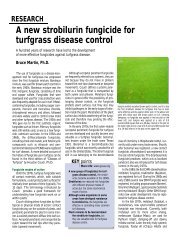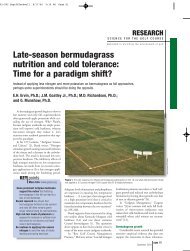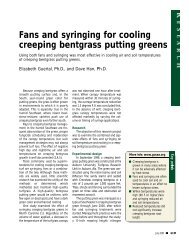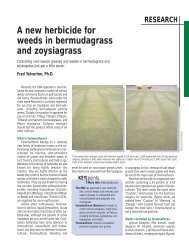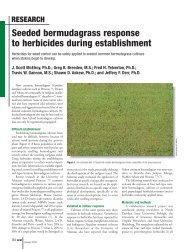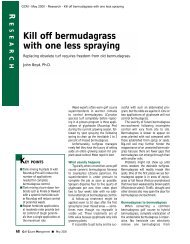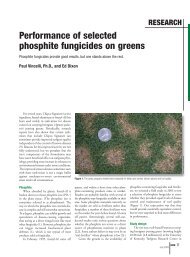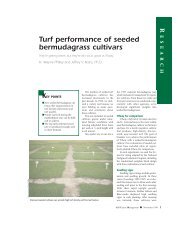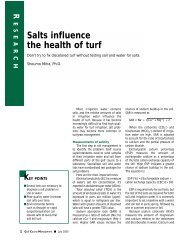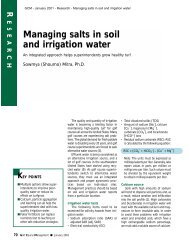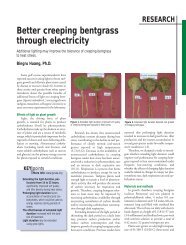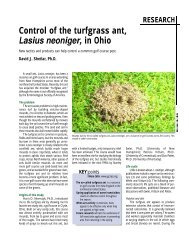Sea Isle 2000 on desert greens: Mowing height and ... - GCSAA
Sea Isle 2000 on desert greens: Mowing height and ... - GCSAA
Sea Isle 2000 on desert greens: Mowing height and ... - GCSAA
Create successful ePaper yourself
Turn your PDF publications into a flip-book with our unique Google optimized e-Paper software.
RESEARCH<br />
This research was funded in part by The Envir<strong>on</strong>mental Institute for Golf,<br />
USGA <strong>and</strong> Cactus <strong>and</strong> Pine GCSA.<br />
<str<strong>on</strong>g>Sea</str<strong>on</strong>g> <str<strong>on</strong>g>Isle</str<strong>on</strong>g> <str<strong>on</strong>g>2000</str<strong>on</strong>g> <strong>on</strong> <strong>desert</strong> <strong>greens</strong>:<br />
<strong>Mowing</strong> <strong>height</strong> <strong>and</strong> nitrogen fertility<br />
The resp<strong>on</strong>se of <str<strong>on</strong>g>Sea</str<strong>on</strong>g> <str<strong>on</strong>g>Isle</str<strong>on</strong>g> <str<strong>on</strong>g>2000</str<strong>on</strong>g> to mowing <strong>height</strong> <strong>and</strong> fertilizer in a <strong>desert</strong> climate may not be what you expect.<br />
David M. Kopec, Ph.D.; James H. Walworth, Ph.D.; Jeffrey J. Gilbert, M.S.;<br />
Greg M. Sower, M.S.; <strong>and</strong> Mohammad Pessarakli, Ph.D.<br />
As interest has increased in turfgrasses that<br />
can tolerate high temperatures <strong>and</strong> less-thanperfect<br />
irrigati<strong>on</strong> water, seashore paspalum<br />
(Paspalum vaginatum) has become more popular<br />
for golf course use. Cultivars released in<br />
the 1970s such as Excalibur <strong>and</strong> Adelaide have<br />
been used with some success in Southern<br />
California, Texas <strong>and</strong> the Gulf Coast area of<br />
the southeastern United States.<br />
<str<strong>on</strong>g>Sea</str<strong>on</strong>g>shore paspalum is a warm-seas<strong>on</strong> grass<br />
with a moderate growth rate that tolerates<br />
heat, salinity <strong>and</strong> flooding. Some of its less<br />
desirable characteristics are vegetative establishment<br />
requirements (although a seeded<br />
variety is now available), a tendency toward<br />
scalping <strong>and</strong> a yellow-green turf color. One of<br />
the most popular new cultivars, <str<strong>on</strong>g>Sea</str<strong>on</strong>g> <str<strong>on</strong>g>Isle</str<strong>on</strong>g> <str<strong>on</strong>g>2000</str<strong>on</strong>g>,<br />
has a low growth habit <strong>and</strong> has been used for<br />
<strong>greens</strong> in the humid southeastern United<br />
States, where it is irrigated with saline water.<br />
Scientists <strong>and</strong> superintendents who have<br />
observed P. vaginatum in humid envir<strong>on</strong>ments<br />
note that it requires much less nitrogen than<br />
most bermudagrass cultivars. It is critical to<br />
investigate the resp<strong>on</strong>se of newer, shorter cultivars<br />
to frequent <strong>and</strong> close mowing <strong>and</strong> to various<br />
applicati<strong>on</strong> rates of nitrogen fertilizati<strong>on</strong>.<br />
<str<strong>on</strong>g>Sea</str<strong>on</strong>g>shore paspalum <strong>on</strong> <strong>greens</strong><br />
We wanted to determine whether seashore<br />
paspalum could successfully be used <strong>on</strong> a green<br />
in a <strong>desert</strong> envir<strong>on</strong>ment. Therefore, we c<strong>on</strong>ducted<br />
a two-year test to investigate the resp<strong>on</strong>se<br />
of <str<strong>on</strong>g>Sea</str<strong>on</strong>g> <str<strong>on</strong>g>Isle</str<strong>on</strong>g> <str<strong>on</strong>g>2000</str<strong>on</strong>g> to three mowing <strong>height</strong>s <strong>and</strong> to<br />
determine the resp<strong>on</strong>se of this grass to nitrogen<br />
fertilizati<strong>on</strong> in a hot, dry climate.<br />
Materials <strong>and</strong> methods<br />
Test site<br />
Starting in <str<strong>on</strong>g>2000</str<strong>on</strong>g>, a putting green built to<br />
USGA recommendati<strong>on</strong>s with <str<strong>on</strong>g>Sea</str<strong>on</strong>g> <str<strong>on</strong>g>Isle</str<strong>on</strong>g> <str<strong>on</strong>g>2000</str<strong>on</strong>g><br />
was mowed at three mowing <strong>height</strong>s: 1 ⁄8, 5 ⁄32<br />
Figure 1. A two-year test investigated the effects of mowing <strong>height</strong>, rolling <strong>and</strong> nitrogen fertility <strong>on</strong> <strong>desert</strong> golf course<br />
putting <strong>greens</strong> planted with <str<strong>on</strong>g>Sea</str<strong>on</strong>g> <str<strong>on</strong>g>Isle</str<strong>on</strong>g> <str<strong>on</strong>g>2000</str<strong>on</strong>g>.<br />
<strong>and</strong> 3 ⁄16 inch (3.2, 4.0 <strong>and</strong> 4.8 millimeters)<br />
(Figure 1). Turf growing at each mowing<br />
<strong>height</strong> received m<strong>on</strong>thly applicati<strong>on</strong>s of nitrogen<br />
(0.25, 0.38, 0.50 or 0.75 pound nitrogen/1,000<br />
square feet [12.2, 18.6, 24.4 or 36.6<br />
kilograms/hectare]) during the growing seas<strong>on</strong>,<br />
which is normally from May to October.<br />
Amm<strong>on</strong>ium nitrate was used to supply nitrogen.<br />
Potash (potassium chloride) was applied<br />
m<strong>on</strong>thly at 0.50 pound potasssium/1,000<br />
square feet, <strong>and</strong> phosphorus from super-phosphate<br />
was applied at 0.50 pound/1,000 square<br />
feet (24.4 kilograms/hectare) every other<br />
m<strong>on</strong>th. Each mowing <strong>height</strong> <strong>and</strong> fertilizer<br />
combinati<strong>on</strong> was replicated four times. Plots<br />
were mowed six times weekly. Turf was not<br />
overseeded between years, as this would interfere<br />
with nitrogen uptake <strong>and</strong> seas<strong>on</strong>al<br />
resp<strong>on</strong>ses to fertility <strong>and</strong> mowing.<br />
Turf resp<strong>on</strong>ses<br />
When possible, we made st<strong>and</strong>ard<br />
m<strong>on</strong>thly NTEP visual evaluati<strong>on</strong>s of color<br />
<strong>and</strong> quality. Ball roll distance was measured<br />
m<strong>on</strong>thly by recording three ball rolls in each<br />
of two directi<strong>on</strong>s from a USGA Stimpmeter<br />
immediately after daily mowing <strong>and</strong> again following<br />
an additi<strong>on</strong>al rolling of the green.<br />
Rolling was not a regular maintenance practice<br />
but was d<strong>on</strong>e <strong>on</strong>ly <strong>on</strong> the day of ball roll<br />
distance measurements.<br />
Results <strong>and</strong> discussi<strong>on</strong><br />
Turfgrass color: <str<strong>on</strong>g>2000</str<strong>on</strong>g> <strong>and</strong> 2001<br />
<str<strong>on</strong>g>Sea</str<strong>on</strong>g> <str<strong>on</strong>g>Isle</str<strong>on</strong>g> <str<strong>on</strong>g>2000</str<strong>on</strong>g> produced a light- to<br />
medium-green turf. Color ratings increased<br />
with increasing mowing <strong>height</strong> (Table 1). The<br />
increases were significant <strong>on</strong> seven of 11 rat-<br />
Photo courtesy of Dave Kopec<br />
84 GCM<br />
November 2005
ing dates, but this trend was c<strong>on</strong>sistent <strong>on</strong><br />
almost every evaluati<strong>on</strong> date. In both <str<strong>on</strong>g>2000</str<strong>on</strong>g><br />
<strong>and</strong> 2001, turf color resp<strong>on</strong>ded positively to<br />
fertilizati<strong>on</strong> rate, with improved color at the<br />
higher levels of nitrogen fertilizati<strong>on</strong>. In general,<br />
turf color was lightest in July (m<strong>on</strong>so<strong>on</strong><br />
period), averaging less than 6.0 in both years.<br />
Turf color scores were noticeably higher in<br />
October 2001 than in October <str<strong>on</strong>g>2000</str<strong>on</strong>g>, probably<br />
because temperatures in fall 2001 were<br />
unseas<strong>on</strong>ably warm.<br />
To maintain a color score of 6.0 or greater<br />
throughout the test, turf mowed at 1 ⁄8 inch<br />
required 0.50 pound nitrogen/1,000 square<br />
feet/m<strong>on</strong>th; turf mowed at 5 ⁄32 required 0.38<br />
pound, <strong>and</strong> turf mowed at 3 ⁄16 inch required<br />
0.25 pound.<br />
TURF COLOR, <str<strong>on</strong>g>2000</str<strong>on</strong>g> & 2001<br />
Turf quality: <str<strong>on</strong>g>2000</str<strong>on</strong>g> <strong>and</strong> 2001<br />
<strong>Mowing</strong> <strong>height</strong> had no c<strong>on</strong>sistent or<br />
significant influence <strong>on</strong> visual quality, <strong>and</strong><br />
turfgrass quality was not influenced by the<br />
combinati<strong>on</strong> of applied nitrogen fertilizer <strong>and</strong><br />
mowing <strong>height</strong> (Table 2).<br />
Turf resp<strong>on</strong>ses to fertilizer were different<br />
each year. In <str<strong>on</strong>g>2000</str<strong>on</strong>g>, turfgrass quality declined<br />
as nitrogen rate increased early in the seas<strong>on</strong><br />
(June). This showed that <str<strong>on</strong>g>Sea</str<strong>on</strong>g> <str<strong>on</strong>g>Isle</str<strong>on</strong>g> <str<strong>on</strong>g>2000</str<strong>on</strong>g> performed<br />
just as well or slightly better when it<br />
received low rates of nitrogen (0.25 <strong>and</strong> 0.38<br />
pound/nitrogen/1,000 square feet/m<strong>on</strong>th).<br />
In general, in turf that was not overseeded,<br />
medium to high rates of nitrogen (0.50<br />
pound/1,000 square feet/m<strong>on</strong>th) improved<br />
turf quality in the spring <strong>and</strong> fall, <strong>and</strong> low rates<br />
of nitrogen (0.25-0.38 pound/1,000 square<br />
feet/m<strong>on</strong>th) provided good turf quality during<br />
the hottest m<strong>on</strong>ths of summer. Across both<br />
years, turf mowed at 1 ⁄8 inch required 0.50<br />
pound nitrogen/1,000 square feet/growing<br />
m<strong>on</strong>th to produce a turf quality score of 6.0<br />
or greater, <strong>and</strong> turf mowed at 5 ⁄32 <strong>and</strong> 3 ⁄16 inch<br />
produced turf quality ratings of 6.0 or higher<br />
when fertilized with <strong>on</strong>ly 0.25 pound nitrogen/1,000<br />
square feet/growing m<strong>on</strong>th. When<br />
not overseeded, seashore paspalum is fully<br />
green from May to October in the <strong>desert</strong>.<br />
Leaf widths<br />
Leaf widths were measured in August<br />
2001. Twelve shoots were sampled from each<br />
plot, <strong>and</strong> leaf width was measured to the nearest<br />
0.1 millimeter. Leaf width showed little<br />
variati<strong>on</strong> across all plots (1.4-1.7 millimeters<br />
for the sec<strong>on</strong>d leaf, <strong>and</strong> 1.4-1.8 millimeters<br />
for the third leaf). Neither mowing <strong>height</strong> nor<br />
RESEARCH<br />
nitrogen fertilizati<strong>on</strong> rates produced profound<br />
effects for leaf texture or leaf width measurements<br />
in <str<strong>on</strong>g>Sea</str<strong>on</strong>g> <str<strong>on</strong>g>Isle</str<strong>on</strong>g> <str<strong>on</strong>g>2000</str<strong>on</strong>g>.<br />
Ball roll distance: <str<strong>on</strong>g>2000</str<strong>on</strong>g><br />
In <str<strong>on</strong>g>2000</str<strong>on</strong>g>, ball roll distance was measured<br />
<strong>on</strong> six calendar dates. On three of these dates,<br />
the <strong>greens</strong> were rolled, <strong>and</strong> ball roll distance<br />
was measured immediately after rolling. In<br />
<str<strong>on</strong>g>2000</str<strong>on</strong>g>, mowing <strong>height</strong> significantly affected<br />
ball roll distance in seven of eight measurements<br />
(Table 3). When averaged over all<br />
nitrogen rates, mean ball roll distance values<br />
ranged from 4 feet, 10.4 inches ( 3 ⁄16 inch<br />
mowing <strong>height</strong>, July 13) to 7 feet, 10.1 inches<br />
( 1 ⁄8 inch mowing <strong>height</strong>, Oct. 31).<br />
In <str<strong>on</strong>g>2000</str<strong>on</strong>g> turf mowed at 1 ⁄8 inch ranked first<br />
for ball roll distance <strong>on</strong> four dates (July 13,<br />
July 28, Aug. 31 <strong>and</strong> Oct. 31) when it was<br />
mowed <strong>and</strong> not rolled <strong>and</strong> ranked first for ball<br />
roll distance <strong>on</strong> two dates when it was mowed<br />
<strong>and</strong> also rolled (Aug. 31, Nov. 7). When turf<br />
was mowed without rolling, turf mowed at 5 ⁄32<br />
inch had greater ball roll distances than turf<br />
mowed at 3 ⁄16 inch in July <strong>and</strong> August but not<br />
in September <strong>and</strong> October.<br />
In general, increases in ball roll distance<br />
were linearly related to a decrease in mowing<br />
<strong>Mowing</strong> <strong>height</strong> (inches)<br />
<str<strong>on</strong>g>2000</str<strong>on</strong>g> ratings 2001 ratings Average,<br />
<str<strong>on</strong>g>2000</str<strong>on</strong>g> &<br />
June 27 July 28 Aug. 28 Sept. 27 Oct. 30 May 17 June 25 July 23 Aug. 21 Sept. 10 Oct. 6 2001<br />
1<br />
⁄8 6.3 5.2 6.3 6.3 5.7 6.5 6.1 5.6 6.6 5.8 6.3 6.0<br />
5<br />
⁄32 6.1 6.3 6.1 6.9 6.3 7.3 6.8 5.8 6.5 6.3 6.8 6.4<br />
3<br />
⁄16 6.0 6.1 6.8 6.6 5.7 7.3 6.8 5.8 7.3 6.8 7.0 6.5<br />
Test mean 6.1 5.9 6.4 6.6 5.9 7.0 6.6 5.7 6.8 6.3 6.7 6.3<br />
LSD ns 0.44 ns ns 0.50 0.68 0.65 ns 0.60 0.87 0.60<br />
Fertilizer rate (pounds/nitrogen/1,000 square feet)<br />
0.25 5.8 5.4 5.8 6.0 5.3 6.1 6.4 5.4 6.3 5.9 6.0 5.9<br />
0.38 5.8 5.7 6.3 6.0 5.4 6.8 6.1 5.8 6.7 6.3 6.3 6.1<br />
0.50 6.1 6.2 6.4 6.8 5.9 7.3 6.8 5.9 6.9 6.2 6.8 6.5<br />
0.75 6.8 6.1 6.9 7.6 6.8 7.9 7.0 5.8 7.3 6.9 7.7 6.9<br />
Test mean 6.1 5.9 6.4 6.6 5.9 7.0 6.6 5.7 6.8 6.3 6.7 6.4<br />
LSD 0.80 ns 0.81 0.40 0.67 0.51 ns ns 0.38 0.69 0.57<br />
Note. Color was rated <strong>on</strong> a scale of 1-9, where 1 = dead, 6= fully acceptable <strong>and</strong> 9 = best possible. Values are the mean of four replicati<strong>on</strong>s. Test mean = mean of all treatments<br />
<strong>on</strong> that date. LSD = Least significant difference mean separati<strong>on</strong> statistic. ns, not significant.<br />
Table 1. Visual color of a <str<strong>on</strong>g>Sea</str<strong>on</strong>g> <str<strong>on</strong>g>Isle</str<strong>on</strong>g> <str<strong>on</strong>g>2000</str<strong>on</strong>g> paspalum putting green under selected mowing <strong>height</strong> <strong>and</strong> fertilizati<strong>on</strong> regimes, summer <str<strong>on</strong>g>2000</str<strong>on</strong>g> <strong>and</strong> 2001, Karsten Turfgrass Research<br />
Facility, University of Ariz<strong>on</strong>a.<br />
November 2005<br />
GCM 85
RESEARCH<br />
VISUAL QUALITY<br />
<strong>height</strong> <strong>on</strong> all dates, whether turf was <strong>on</strong>ly<br />
mowed or mowed <strong>and</strong> then rolled (Figure 2).<br />
Interestingly, in September <strong>and</strong> October, turf<br />
at 3 ⁄16 inch that was double-mowed <strong>and</strong> also<br />
rolled <strong>on</strong>ce produced a greater ball roll distance<br />
(7 feet, 4.1 inches) than the 5 ⁄32 inch turf<br />
that was not rolled (6 feet, 9.5 inches).<br />
Because nitrogen fertilizer rate generally<br />
had little effect <strong>on</strong> ball roll distance, those data<br />
are not included. Nitrogen fertilizer rate was<br />
2001 ratings Average, <str<strong>on</strong>g>2000</str<strong>on</strong>g><br />
May 17 June 25 July 23 Aug. 21 Sept. 10 Oct. 6 & 2001<br />
<strong>Mowing</strong> <strong>height</strong> (inches)<br />
1<br />
⁄8 6.0 6.5 6.3 7.3 6.9 6.7 6.5<br />
5<br />
⁄32 7.2 7.1 6.4 6.8 7.1 6.8 6.9<br />
3<br />
⁄16 6.7 6.8 6.8 6.9 6.8 6.8 6.8<br />
Test mean 6.6 6.8 6.5 7.0 6.9 6.7 6.8<br />
LSD ns ns ns ns ns ns<br />
Fertilizer rate (pounds nitrogen/1,000 square feet)<br />
0.25 6.2 6.3 6.4 7.4 7.6 7.7 6.8<br />
0.38 6.3 6.8 6.3 7.0 6.9 6.8 6.7<br />
0.50 6.8 6.8 6.8 7.0 6.7 6.4 6.8<br />
0.75 7.1 7.3 6.3 6.4 6.7 6.0 6.7<br />
Test mean 6.6 6.8 6.5 7.0 6.9 6.7 6.7<br />
LSD 0.80 0.92 ns 0.66 0.73 0.51<br />
Note. Quality is rated <strong>on</strong> a scale of 1-9, where 1 = dead, 6 = fully acceptable <strong>and</strong> 9 = best possible. Values are<br />
the mean of four replicati<strong>on</strong>s. Test mean = mean of all treatments <strong>on</strong> that date. LSD, least significant difference.<br />
ns, not significant.<br />
Table 2. Visual turf quality of <str<strong>on</strong>g>Sea</str<strong>on</strong>g> <str<strong>on</strong>g>Isle</str<strong>on</strong>g> <str<strong>on</strong>g>2000</str<strong>on</strong>g> seashore papsalum under select mowing <strong>height</strong>s <strong>and</strong> nitrogen fertilizati<strong>on</strong>,<br />
summer 2001, <strong>and</strong> average of summer <str<strong>on</strong>g>2000</str<strong>on</strong>g> <strong>and</strong> summer 2001, Karsten Turfgrass Research Facility,<br />
University of Ariz<strong>on</strong>a.<br />
significant statistically for two of eight ball roll<br />
distance measurements, both of which did not<br />
involve rolling the green.<br />
In general, the low rate of fertilizer (0.25<br />
pound nitrogen/1,000 square feet/m<strong>on</strong>th)<br />
increased ball roll distances by 2-4 inches over<br />
all other rates of applied nitrogen. Although<br />
this is statistically significant, it is not important<br />
in terms of turfgrass management.<br />
Ball roll distance: 2001<br />
In 2001, ball roll distance was measured<br />
12 times (six with rolling <strong>and</strong> six without<br />
rolling each m<strong>on</strong>th for six m<strong>on</strong>ths).<br />
Decreasing mowing <strong>height</strong> increased ball roll<br />
distance, whether or not the turf received supplemental<br />
rolling. In general, rolling 1 ⁄8-inch<br />
turf added about 6 inches to ball roll distance<br />
in May <strong>and</strong> June compared to identical plots<br />
that were mowed <strong>and</strong> not rolled. This was not<br />
true in mid-summer, when rolling decreased<br />
ball roll distance by 3-4 inches. As in <str<strong>on</strong>g>2000</str<strong>on</strong>g>,<br />
nitrogen fertility rate had no statistical or biological<br />
effect <strong>on</strong> ball roll distance.<br />
For all measuring dates, ball roll distance<br />
decreased as mowing <strong>height</strong> increased in both<br />
rolled <strong>and</strong> unrolled turf. In general, the greatest<br />
difference in ball roll distance occurred<br />
between the 5 ⁄32-inch <strong>and</strong> 3 ⁄16-inch mowing<br />
<strong>height</strong>s. Ball roll distance was generally l<strong>on</strong>ger<br />
<strong>and</strong> more c<strong>on</strong>sistent in 2001 than in <str<strong>on</strong>g>2000</str<strong>on</strong>g>.<br />
Ball roll distance was greatest in June <strong>and</strong><br />
BALL ROLL, <str<strong>on</strong>g>2000</str<strong>on</strong>g> & 2001<br />
<str<strong>on</strong>g>2000</str<strong>on</strong>g> ball roll distance (feet, inches)<br />
<strong>Mowing</strong> <strong>height</strong> July 13 July 28 Aug. 31 Sept. 26 Oct. 31 Nov. 7<br />
1<br />
⁄8 inch 5, 10.1 6, 1.2 6, 8.3 7, 3.8 7, 3.0 7, 4.1 7, 10.1 8, 9.8<br />
5<br />
⁄32 inch 5, 6.8 5, 11.7 6, 4.3 6, 8.8 6, 9.5 6, 11.9 7, 2.5 7, 10.4<br />
3<br />
⁄16 inch 4, 10.4 4, 11.6 5, 8.3 6, 4.5 7, 3.9 7, 4.1 7, 6.5 8, 2.2<br />
Test mean 5, 5.1 5, 8.1 6, 3.0 6, 9.7 7, 1.5 7, 2.7 7, 6.4 8, 3.5<br />
LSD 1.4 4.6 2.1 4.2 6.1 3.1 ns 3.6<br />
2001 ball roll distance (feet, inches)<br />
<strong>Mowing</strong> <strong>height</strong> May 22 June 27 July 20 Aug. 21 Aug. 23 Sept. 26 Oct. 10<br />
1<br />
⁄8 inch 6, 6.9 7, 0.9 8, 4.4 8, 11.9 7, 5.4 7, 8.4 7, 2.8 7, 0.8 6, 10.2 7, 1.3 7, 2.0 8, 4.7<br />
5<br />
⁄32 inch 6, 1.0 6, 3.7 6, 0.2 6, 4.3 6, 2.3 6, 2.3 6, 9.8 6, 8.5 6, 4.9 6, 8.0 6, 7.8 6, 11.0<br />
3<br />
⁄16 inch 5, 8.6 5, 10.4 5, 4.9 5, 10.7 5, 7.4 5,9.4 6, 0.7 5, 10.5 5, 10.8 5, 11.2 6, 0.1 6, 3.9<br />
Test mean 6, 1.5 6, 5.0 6, 7.2 7, 0.9 6, 5.1 6, 6.7 6, 8.4 6, 6.6 6, 4.6 6, 6.8 6, 7.3 6, 11.2<br />
LSD 2.3 1.8 5.2 8.1 3.6 2.3 3.3 5.4 5.2 3.6 4.1 5.0<br />
Table 3. Ball roll (three rolls east to west, <strong>and</strong> three rolls west to east), in inches, from a <str<strong>on</strong>g>Sea</str<strong>on</strong>g> <str<strong>on</strong>g>Isle</str<strong>on</strong>g> <str<strong>on</strong>g>2000</str<strong>on</strong>g> green in summer <str<strong>on</strong>g>2000</str<strong>on</strong>g> <strong>and</strong> 2001, Karsten Turfgrass Research Facility,<br />
University of Ariz<strong>on</strong>a. Values in light green columns are measurements from rolled green treatment.<br />
86 GCM<br />
November 2005
sec<strong>on</strong>d-highest in July. Rolling increased ball<br />
roll distance across all mowing <strong>height</strong>s <strong>and</strong><br />
nitrogen fertilizer treatments. Rolling provided<br />
the greatest benefit in May <strong>and</strong><br />
October, which are periods of slower growth<br />
for warm-seas<strong>on</strong> grass.<br />
A single rolling increased ball roll distance<br />
by 6 inches for turf mowed at 1 ⁄8 inch in May,<br />
June <strong>and</strong> July, with <strong>on</strong>ly a 3- to 4-inch<br />
increase in September <strong>and</strong> October 2001. It<br />
is argued that golfers cannot notice ball roll<br />
distance increases of less than 10 inches, in<br />
which case, rolling would be insignificant as<br />
a tournament tool. However, some form of<br />
regular rolling may be necessary to obtain <strong>and</strong><br />
maintain acceptable ball roll distance values in<br />
seashore paspalum in a <strong>desert</strong> climate.<br />
Ball roll distance: <str<strong>on</strong>g>2000</str<strong>on</strong>g> <strong>and</strong> 2001<br />
<strong>Mowing</strong> <strong>height</strong> had a greater effect <strong>on</strong> ball<br />
speed than applied nitrogen fertilizer rates in<br />
both years. The rates of applied nitrogen rates<br />
included in this test had minimal affect <strong>on</strong><br />
ball roll distance.<br />
Rolling increased ball roll distance more in<br />
<str<strong>on</strong>g>2000</str<strong>on</strong>g> than in 2001, but summer ball roll distances<br />
were greater overall in 2001. The greatest<br />
ball roll distance — 8 feet, 11.9 inches —<br />
was measured in June 2001. In general, ball<br />
roll distance <strong>on</strong> turf mowed at 1 ⁄8 inch was 10<br />
to 22 inches greater than <strong>on</strong> turf mowed at 3 ⁄16<br />
inch. Rolling added anywhere from 4 to 12<br />
BALL ROLL DISTANCE<br />
Ball roll distance<br />
100<br />
90<br />
80<br />
70<br />
60<br />
50<br />
40<br />
30<br />
20<br />
10<br />
0<br />
THE RESEARCH says . . .<br />
Figure 2. Ball roll distance of <str<strong>on</strong>g>Sea</str<strong>on</strong>g> <str<strong>on</strong>g>Isle</str<strong>on</strong>g> <str<strong>on</strong>g>2000</str<strong>on</strong>g> Paspalum was measured <strong>and</strong> averaged over two years at three<br />
mowing <strong>height</strong>s.<br />
RESEARCH<br />
➤ <str<strong>on</strong>g>Sea</str<strong>on</strong>g> <str<strong>on</strong>g>Isle</str<strong>on</strong>g> <str<strong>on</strong>g>2000</str<strong>on</strong>g> tolerated mowing at 1 ⁄8 inch for two years in a <strong>desert</strong> climate when mowed six<br />
times weekly with a Toro Series 5 Tournament Mower using a grooved fr<strong>on</strong>t roller.<br />
➤ <str<strong>on</strong>g>Sea</str<strong>on</strong>g> <str<strong>on</strong>g>Isle</str<strong>on</strong>g> <str<strong>on</strong>g>2000</str<strong>on</strong>g> ranged from light to light-medium green in color, depending <strong>on</strong> mowing <strong>height</strong><br />
<strong>and</strong> fertilizati<strong>on</strong>. In general, the inherent color of <str<strong>on</strong>g>Sea</str<strong>on</strong>g> <str<strong>on</strong>g>Isle</str<strong>on</strong>g> <str<strong>on</strong>g>2000</str<strong>on</strong>g> paspalum is lighter than<br />
Tifgreen 328 bermudagrass (l<strong>on</strong>g-term observati<strong>on</strong>s).<br />
➤ In general, it was possible to maintain turfgrass quality of 6.0 or greater at the following<br />
mowing <strong>height</strong>s <strong>and</strong> pounds of applied nitrogen/1,000 square feet: 1 ⁄8 inch <strong>and</strong> 0.50 pound;<br />
5<br />
⁄32 inch <strong>and</strong> 0.38 pound; 3 ⁄16 inch <strong>and</strong> 0.25 pound.<br />
➤ Ball roll distance was affected more by mowing <strong>height</strong> than by nitrogen fertilizati<strong>on</strong> rates.<br />
➤ The differences between treatments for ball roll distances were anywhere from 20-40<br />
inches within a given year.<br />
➤ The greatest ball roll distance was 8 feet, 11.9 inches in July 2001 <strong>on</strong> turf mowed at<br />
1<br />
⁄8 inch, which would be c<strong>on</strong>sidered suitable for tournament play.<br />
inches to ball roll distance. In this study, rolling<br />
took place <strong>on</strong>ly <strong>on</strong>ce a m<strong>on</strong>th <strong>and</strong> <strong>on</strong>ly <strong>on</strong> the<br />
day that ball roll distance was measured.<br />
USGA st<strong>and</strong>ards classify a ball roll distance<br />
of 8 feet, 4 inches as medium (just short of fast)<br />
for regular membership play. However, most ball<br />
roll distances in turf mowed at 1 ⁄8 inch averaged<br />
about 7 feet, 3 inches, which would qualify as<br />
medium in regular play. Under the management<br />
c<strong>on</strong>diti<strong>on</strong>s of this test (vertical mowing <strong>and</strong> topdressing<br />
every 14 days), all other ball roll distance<br />
values obtained at mowing <strong>height</strong>s of 5 ⁄32 <strong>and</strong> 3 ⁄16<br />
inch would be c<strong>on</strong>sidered marginal. Within each<br />
mowing <strong>height</strong>, fertility did not appreciably<br />
affect ball roll distance.<br />
■ 1 ⁄8 inch ■ 5 ⁄32 inch ■ 3 ⁄16 inch<br />
Rolled<br />
Not rolled<br />
Acknowledgments<br />
We thank The Envir<strong>on</strong>mental Institute for Golf,<br />
Cactus <strong>and</strong> Pine GCSA, USGA <strong>and</strong> The Toro Co. for helping<br />
to fund this research.<br />
References<br />
1. Beard, J.B., S.I. Sifers <strong>and</strong> M.H. Hall. 1991a. Cutting<br />
<strong>height</strong> <strong>and</strong> nitrogen fertility requirements of Adalayd<br />
seashore paspalum (Paspalum vaginatum). Texas<br />
Turfgrass Research PR-4921:107-109.<br />
2. Beard, J.B., S.I. Sifers <strong>and</strong> W.G. Menn. 1991b.<br />
Cultural strategies for seashore paspalum. Grounds<br />
Maintenance 8:32, 62.<br />
3. Huang, B., R.R. Duncan <strong>and</strong> R.N. Carrow. 1997a.<br />
Drought resistance mechanisms of seven warmseas<strong>on</strong><br />
turfgrasses under surface soil drying. I. Shoot<br />
resp<strong>on</strong>se. Crop Science 37(6):1858-1863.<br />
4. Huang, B., R.R. Duncan <strong>and</strong> R.N. Carrow. 1997b.<br />
Drought resistance mechanisms of seven warmseas<strong>on</strong><br />
turfgrasses under surface soil drying. II. Root<br />
aspects. Crop Science 37(6):1863-1866.<br />
5. Marcum, K.B., <strong>and</strong> C.L. Murdoch. 1994. Salinity tolerance<br />
mechanisms of six C4 turfgrasses. Journal of<br />
the American Society of Horticultural Science<br />
119(4):779-784.<br />
6. Sigua, G.C., <strong>and</strong> W.H. Hudnaill. 1992. Nitrogen <strong>and</strong><br />
gypsum: Management tools for revegetati<strong>on</strong> <strong>and</strong><br />
productivity improvement of a brackish marsh in<br />
southwest Louisiana. Communicati<strong>on</strong>s in Soil<br />
Science <strong>and</strong> Plant Analysis 23(3&4):283-299.<br />
7. Trenholm, L.E., R.N. Carrow <strong>and</strong> R.R. Duncan. 2001.<br />
Wear tolerance, growth, <strong>and</strong> quality of seashore paspalum<br />
in resp<strong>on</strong>se to nitrogen <strong>and</strong> potassium.<br />
HortScience 36(4):780-783.<br />
8. USGA. 1996. Stimpmeter instructi<strong>on</strong> booklet. USGA,<br />
Far Hills, N.J. www.usga.org/turf/articles/management/<br />
<strong>greens</strong>/stimpmeter.html. Verified Sept. 13, 2005.<br />
David M. Kopec is an Extensi<strong>on</strong> specialist in turfgrass,<br />
Jeffrey J. Gilbert is a senior research specialist, <strong>and</strong><br />
Mohammad Pessarakli is a research faculty member <strong>and</strong><br />
lecturer in the plant science department at the University of<br />
Ariz<strong>on</strong>a, Tucs<strong>on</strong>. James H. Walworth is an Extensi<strong>on</strong> specialist<br />
in soil fertility <strong>and</strong> Greg M. Sower is a former<br />
research technician in the soil, water <strong>and</strong> envir<strong>on</strong>mental<br />
sciences department at the University of Ariz<strong>on</strong>a, Tucs<strong>on</strong>.<br />
November 2005<br />
GCM 87



